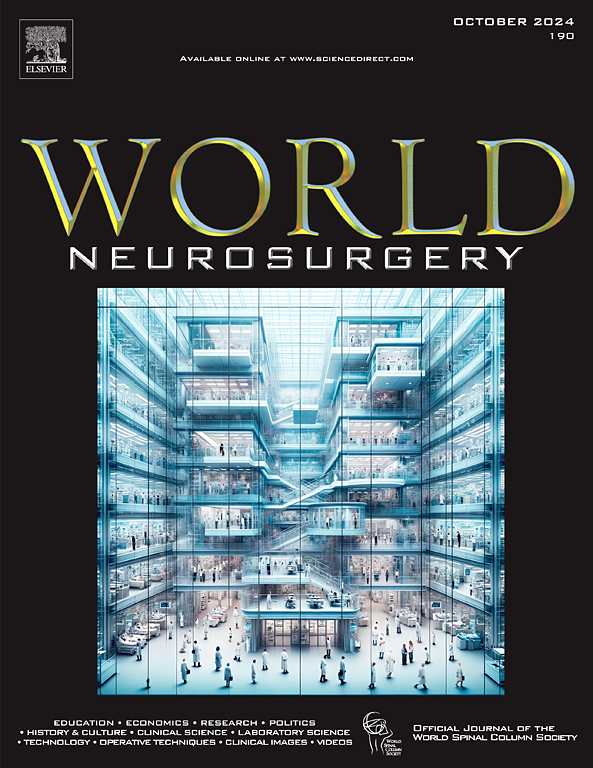寰枕后膜张力释放技术在椎动脉第三段水平段手术暴露中的应用:解剖学和临床研究。
IF 1.9
4区 医学
Q3 CLINICAL NEUROLOGY
引用次数: 0
摘要
目的:本研究旨在阐明椎动脉第三节(V3h)水平部分周围静脉结构(VS)的解剖原理,并开发一种安全、无血的V3h暴露手术技术。方法:采用10具经福尔马林注射的尸体头部标本进行研究。逐步进行解剖以模拟远侧入路过程,用一种新技术暴露V3h。此外,我们将该技术应用于10例接受远侧或极侧入路的患者。结果:V3h周围的VS分为椎静脉丛(VVP)、枕下海绵窦(SCS)和吻合静脉(AV)三个部分。寰枕后膜(PAOM)是颅椎交界处(CVJ)的弹性筋膜层,从枕骨鳞片骨膜延伸至寰椎后弓。它在枕下三角(SOT)内腹侧附着于VS,形成一个帐篷状结构,保持张力并确保V3h左右VS的丰满。我们发现,通过释放膜上的张力,减少帐篷状结构上的张力,可以实现SOT内静脉窦的塌陷,从而减少术中出血,提高手术效率。此外,我们成功地处理了10例临床病例,在临床病例中采用PAOM张力释放技术(PTRT),无术中椎动脉损伤的报道。结论:应用PTRT可有效瓦解SOT内的帐篷状结构,显著减少CVJ V3h暴露时出血。本文章由计算机程序翻译,如有差异,请以英文原文为准。
The Application of the Posterior Atlanto-Occipital Membrane Tension Release Technique for Surgical Exposure of the Horizontal Part of the Vertebral Artery's Third Segment: An Anatomical and Clinical Investigation
Objective
This study aims to elucidate the anatomical principles governing the surrounding venous structures (VS) of the horizontal part of the third segment of the vertebral artery (V3h) and develop a safe and bloodless surgical technique for exposing V3h.
Methods
This study used 10 formalin-infused cadaveric head specimens. The dissections were performed stepwise to simulate the far lateral approach process, exposing the V3h with a novel technique. Additionally, we applied this technique to 10 patients undergoing far or extreme lateral approaches.
Results
The VS surrounding V3h is divided into 3 components: the vertebral venous plexus, suboccipital cavernous sinus, and the anastomotic vein. The posterior atlanto-occipital membrane (PAOM), a resilient fascial layer in the craniovertebral junction, extends from the periosteum of the occipital squama to the posterior arch of the atlas. It adheres ventrally to the VS within the suboccipital triangle (SOT), forming a tent-like structure that maintains tension and ensures fullness of the VS around V3h. We discovered that by releasing tension in this membrane and reducing strain on this tent-like structure, the collapse of the venous sinus within the SOT can be achieved, resulting in reduced intraoperative bleeding and improved surgical efficiency. Additionally, we successfully managed 10 clinical cases employing the PAOM tension release technique in clinical cases, with no reported incidents of intraoperative vertebral artery injury.
Conclusions
The application of the PAOM tension release technique effectively collapses the tent-like structure within the SOT, significantly reducing bleeding during V3h exposure in craniovertebral junction.
求助全文
通过发布文献求助,成功后即可免费获取论文全文。
去求助
来源期刊

World neurosurgery
CLINICAL NEUROLOGY-SURGERY
CiteScore
3.90
自引率
15.00%
发文量
1765
审稿时长
47 days
期刊介绍:
World Neurosurgery has an open access mirror journal World Neurosurgery: X, sharing the same aims and scope, editorial team, submission system and rigorous peer review.
The journal''s mission is to:
-To provide a first-class international forum and a 2-way conduit for dialogue that is relevant to neurosurgeons and providers who care for neurosurgery patients. The categories of the exchanged information include clinical and basic science, as well as global information that provide social, political, educational, economic, cultural or societal insights and knowledge that are of significance and relevance to worldwide neurosurgery patient care.
-To act as a primary intellectual catalyst for the stimulation of creativity, the creation of new knowledge, and the enhancement of quality neurosurgical care worldwide.
-To provide a forum for communication that enriches the lives of all neurosurgeons and their colleagues; and, in so doing, enriches the lives of their patients.
Topics to be addressed in World Neurosurgery include: EDUCATION, ECONOMICS, RESEARCH, POLITICS, HISTORY, CULTURE, CLINICAL SCIENCE, LABORATORY SCIENCE, TECHNOLOGY, OPERATIVE TECHNIQUES, CLINICAL IMAGES, VIDEOS
 求助内容:
求助内容: 应助结果提醒方式:
应助结果提醒方式:


